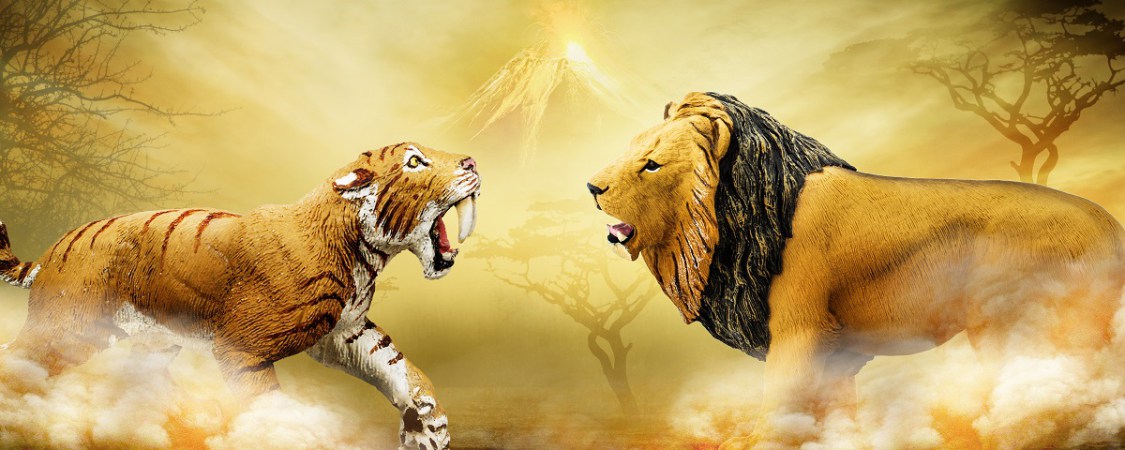
Animals and Ancestors Part 2
In a previous blog post, we discussed present day animals and how they compared to their ancestors and prehistoric relatives, and the results were quite surprising. Sometimes the ancient animals were much larger than their modern counterparts, and often they lived in different habitats and looked almost nothing alike, with many unique adaptations to help them survive in their environments. But as we mentioned in that post, there is an amazing amount of animal diversity, both past and present…so we had enough material left over for a part two! Here are a few more contemporary creatures compared with their extinct cousins.
Last time, we started with crocodiles, so that seems like a good place to begin again. We previously talked about two crocodile relatives that lived in the Late Jurassic and Cretaceous Periods. This time, we’re going to go back even further, to the Late Triassic, around 210 million years ago. There you’ll find Postosuchus, a large predatory reptile that lived in North America. At first glance, it looks more like a dinosaur than a crocodile, with its legs held erect underneath its body instead of splayed out to the side, and a large head that is narrow and deep, compared to the wide flattened skull of most crocs. It was a rauisuchian, an informal grouping of early crocodile relatives that lived alongside the earliest of the dinosaurs. The crocodylomorphs, a more specific group that developed later and includes modern day crocodilians, is thought to have evolved from a rauisuchian ancestor.


Many people often lump all prehistoric reptiles in with the dinosaurs, but as we’ve seen with crocodile relatives, dinosaurs were far from the only fearsome reptilians around back in the day. There were also some pretty large lizards. Today, the largest lizard is the Komodo dragon, which grows to ten feet long. That’s pretty impressive, but 75 million years ago the water-dwelling mosasaurs could grow four to five times that size! These aquatic lizards were closely related to monitor lizards like the Komodo dragon, but were fully adapted for life underwater, with paddle-shaped flippers instead of feet and specialized tail flukes that helped propel them through the seas. Two of the largest examples were Tylosaurus and Mosasaurus, and while dinosaurs ruled the land, these massive lizards reigned over the oceans.
Now let’s jump forward in time a bit, to around ten million years ago. Here we’ll find some interesting elephant relatives. Everyone knows about woolly mammoths, but the elephant relatives (collectively called proboscideans) were quite a diverse group. One of the most unusual proboscideans were the Amebelodonts, which are also known as “shovel tuskers”. In addition to trunks and tusks in their upper jaws like modern elephants, Amebelodon also had a pair of flattened tusks protruding from its lower jaw that give it its common name. These tusks were thought to be very versatile, helping the animal in different feeding practices, from digging up water plants to scraping bark from trees. While most life reconstructions portray Amebelodon with a short, flattened trunk, there is evidence that its trunk was actually thin and flexible like a modern elephant’s. Ultimately, lacking more preserved remains, such information requires a certain amount of speculation.
Moving on to just about ten thousand years ago, we’ll find an animal that you may already be familiar with: the Smilodon, which you may know as the “saber-toothed tiger”. Despite this name, the Smilodon was not a tiger at all, and was instead a member of an extinct group of cats called Machairodonts. Though all of these saber-toothed cats are found in the family Felidae with other “true” cats, they are not the direct ancestors of today’s lions and tigers. While similar in size, Smilodon had a stockier build, shorter legs and a very short tail. While the exact function of its enlarged canine teeth is a mystery, it’s believed they were used to take down their prey, which included large mammoths. Often, Smilodons would be attracted to an animal that became trapped in a tar pit, and would themselves become trapped while attempting to attack the prey animal. This has led to thousands of skeletons being discovered in areas such as the La Brea Tar Pits in Los Angeles, California.
No one knows exactly why Smilodons became extinct, though many people believe it was due to climate change and competition with humans. These factors are still threatening animals today, as overhunting and overfishing threatens to disrupt the food chain, and climate change is being hurried along by human activity. While there may not be anything we can do to bring back the extinct saber-toothed cats and shovel-tuskers, we can take steps to prevent future extinctions from being caused by human actions.
Bernie’s Bonus Matching Game: Just like last time, you can learn about animals and their ancestors by staging an activity in which children match the Safari Ltd® figures of modern day animals with the figures of their prehistoric relatives. Some of these may be easy; for example, it’s pretty obvious that Smilodon is a cat, and that Amebelodon is related to elephants. However, the reptiles can get a bit trickier. Postosuchus’s crocodilian nature is revealed by the bony scutes on its back, while Tylosaurus shares its forked tongue with the Komodo dragon (visible on our Incredible Creatures figure).







 Facebook
Facebook
 Twitter
Twitter
 Instagram
Instagram
